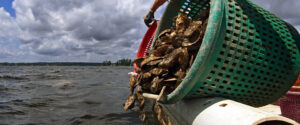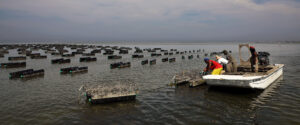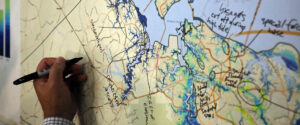Carol Hopper-Brill says ‘aloha’
after 15 years as a VIMS marine educator
Whether she’s exploring a mudflat with teachers or pointing out the surprising detail of microscopic sand, marine education specialist Carol Hopper-Brill says showing the wonders of nature has been a highlight of her career.
“It’s fun to see their joy in discovering something,” said Hopper-Brill, a Virginia Sea Grant extension specialist. “If I were to sum up what the things that have meant the most to me in my career, it’s been when I’ve been able to help someone have a sense of wonder about something.”
Hopper-Brill retired at the end of June after spending 15 years on the Marine Advisory Program’s education team at the Virginia Institute of Marine Science (VIMS). She joined the education team part-time in 2005 to work on the Bridge ocean education website, and soon took on a full-time role to lead programs and events geared toward marine science educators.
Hopper-Brill coordinated the Blue Crab Bowl, a statewide ocean science knowledge competition that brings together roughly 200 high schoolers, coaches, and volunteers each year. She also assisted with the GK-12 program, where graduate science students went to classrooms to teach lessons based on their research, as well as the VA SEA program, a scientist and educators alliance that translates graduate research into classroom activities.
“Carol is a consummate educator and a consummate biologist, and so her desire to share knowledge is never-ending,” said Celia Cackowski, a marine education specialist with VIMS MAP. “Every moment you spend with her, you’re learning something.”
Hopper-Brill also coordinated the marine education activities in the pavilion for VIMS Marine Science Day each year, along with many other educational demos for outreach events. Hopper-Brill has designed countless hands-on activities to bring marine science to life for educators, students, and the public. One activity mimics how scallops “see” their surroundings, where the kids put on a set of goggles with beads to show a scallop’s perspective.
“Who thinks about that? Carol does. She came up with this idea, she engineered the design, and the kids loved it,” said Christopher Petrone, a former MAP education specialist who worked with Hopper-Brill. “I have rarely seen an exhibit or an activity or demo she has run that people didn’t appreciate and learn something from.”
One of Hopper-Brill’s favorite activities has been the sand labs that show the wide variety of sands through the lens of the microscope. The activity points out some of the differences—like the colorful confetti of tiny sea creature skeletons, or deep red grains made of garnet—and discusses the environments that form these sands.
She has used sand demonstrations several years during the summer teacher’s workshops held at the VIMS Eastern Shore Lab in Wachapreague. The four-day “Teachers on the Estuary” workshop gives teachers an opportunity to explore seaside habitats like the barrier islands and mud flats, as well as bayside habitats like eelgrass beds and marshes.
“When you get them out there and they’re mucking about and digging up worms, and doing all those things, it just becomes such a real experience for them” Hopper-Brill said.
“Trying to talk to a grandparent and a 3- or 4-year-old kid at the same time about a science topic taught me a lot about how people are learners,” Hopper-Brill said.
Whether organizing a regional event or answering a middle-schooler’s email about marine science, Hopper-Brill addressed any task with thoughtfulness and care.
Apart from her creative and informative demonstrations, Hopper-Brill is also known among colleagues for her attention to detail and organization. Whether organizing a regional event or answering a middle-schooler’s email about marine science, Hopper-Brill addressed any task with thoughtfulness and care.
“She gets requests from teachers needing resources, or just any member of the community asking questions about marine science stuff,” said Lisa Lawrence, MAP marine education team leader. “She handles all of that.”
In recognition of all her work, Hopper-Brill was named the Mid-Atlantic Marine Education Association’s Informal Educator Award in 2011 and was recognized last year at VIMS for her role as an ambassador to the general public. She also served in multiple leadership roles for MAMEA over the course of her career.
Hopper-Brill began her career as a marine educator at the Waikiki Aquarium in Hawai’i, when she joined their education team while completing her Ph.D. in marine zoology at the University of Hawai’i-Manoa.
“I just really found that I enjoyed trying to translate science into experiences or language or learning tools that other people could use,” Hopper-Brill said. “Trying to talk to a grandparent and a 3- or 4-year-old kid at the same time about a science topic taught me a lot about how people are learners.”
During retirement, Hopper-Brill has plans to spend more spare time on projects like gardening and sorting through the 400-plus samples in her sand collection. She also plans to volunteer as a marine educator.
“I don’t know that she grasps the number of teachers and informal educators that she’s helped over the course of her career—it’s a tremendous number,” Petrone said. “I can’t even fathom how many people have been impacted by her.”
Photos and video by Aileen Devlin | Virginia Sea Grant
Additional photos provided by Celia Cackowski and Sarah McGuire Nuss | VIMS
Story by Madeleine Jepsen | Virginia Sea Grant
Published July 6, 2020.
“I don’t know that she grasps the number of teachers and informal educators that she’s helped over the course of her career—it’s a tremendous number,” Petrone said.





